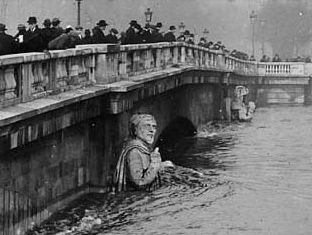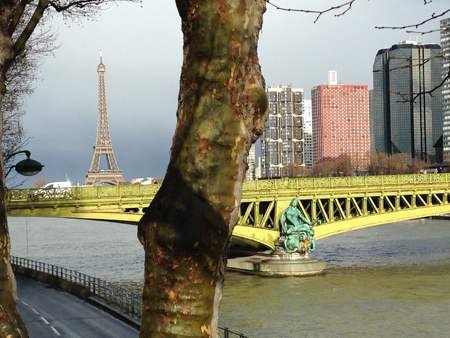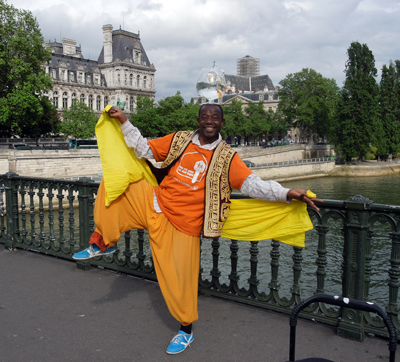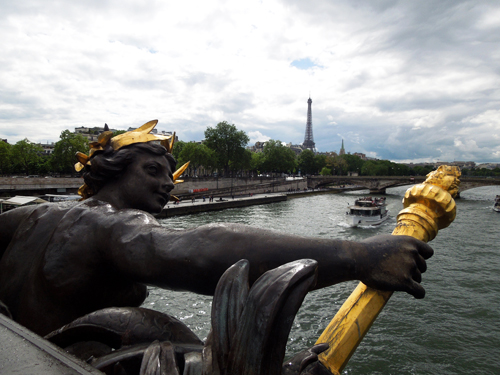Water in Paris, Part 4:
Crossing the Seine
The first bridges were wooden constructions in the middle ages. They were lined with shops and houses. They were easily destroyed by floods or fire or sometimes deliberately to prevent invasion. Seven bridges were added in the 17th century of which three remain: Pont-neuf, pont Marie and pont Royal. Today the Seine is crossed by 37 bridges in the nearly 13 kilometers that it runs through Paris. For a complete list see Wikipedia, but here’s a few of our personal favorites.
The Pont d’Alma, while not overly pretty does have an interesting sculpture. The bridge was originally constructed in 1855 in stone and commemorated the 1854 Franco-English victory over Russia at Alma. The original bridge was thus decorated with four statues that represented the four armies that fought at Alma. There was a Grenadier, a Zouave (north African foot soldier), a Chasseur and an Artilleur. The Zouave became, over time, the unofficial scale by which level of the Seine was measured. When his feet were in the water the Seine was said to be at flood stage. When the water reaches his ankles the river is too high for some boats and navigation is partially curtailed, at his thighs the Seine is too high for all boat traffic such as in the winter of 1982. The water reached his shoulders during the great flood of 1910. When the bridge was rebuilt in 1974 the now famous and indispensable Zouave was reinstalled on the pillar of the bridge. The last time he had his feet in the water was in 2018. The official flood gauge is at Pont d’Austerlitz.
The Pont du Carrousel. The name refers to a festival given by Louis XIV which took place where the bridge now meets the right bank in front of the Louvre, one of Louis XIV’s palaces. The festival presented a carrousel of five quadrilles of ten trained horses. Constructed in 1834 and rebuilt in 1939 the bridge features statues representing Industry, Abundance, The City of Paris and The Seine. An interesting detail is that the two candelabras at each extremity are telescopic and change from 12 meters high during the day to 22 meters high at night. They still work and if you pass by at sundown you might be lucky enough to see them grow. This was an aesthetic choice which allowed the lights to light the whole span of the bridge at night, but without disturbing the elegant proportions of the bridge during the day.
The Pont Mirabeau was constructed in metal at the end of the 19th century by Résal, the same engineer who did the Pont Alexandre III and the Debilly footbridge. It is also decorated by four statues representing navigation on the river. If you look closely you might think that some of the statues seem to be placed backwards – facing the bridge rather than the river. Look again and you’ll see that the statues are arranged two by two as if in the prow and stern of a boat and that on one end of the bridge the two face downstream and the other end they face upstream. The bridge inspired the poem by Guillaume Apollinaire:
Le Pont Mirabeau
Sous le pont Mirabeau coule la Seine
Et nos amours
Faut-il qu’il m’en souvienne
La joie venait toujours après la peine.
Vienne la nuit sonne l’heure
Les jours s’en vont je demeure
Les mains dans les mains restons face à face
Tandis que sous
Le pont de nos bras passe
Des éternels regards l’onde si lasse
Vienne la nuit sonne l’heure
Les jours s’en vont je demeure
L’amour s’en va comme cette eau courante
L’amour s’en va
Comme la vie est lente
Et comme l’Espérance est violente
Vienne la nuit sonne l’heure
Les jours s’en vont je demeure
Passent les jours et passent les semaines
Ni temps passé
Ni les amours reviennent
Sous le pont Mirabeau coule la Seine.
It is always interesting to look at parallel events in history. For example the Pont des Arts was constructed while Lewis and Clark explored the American west 1802-1804. The bridge was named after the Louvre which at the time was called the palais des arts. It was a cast iron toll bridge for foot traffic and resembled a hanging garden with trees, flower and benches. The bridge was damaged during World War II and following several barge collisions in the 1960s-70s it finally was closed just before part of it collapsed. It was rebuilt in 1984. The bridge has been used in more than a dozen films and is mentioned in at least ten songs.
Pont d’Arcole got it’s name in 1898 in reference to an event in 1830 during which an insurgent in was killed while planting a tricolor flag on the bridge. Legend says the insurgent called out that his name was d’Arcole. He may have also been referring to the Battle of Arcole (1796 near Verona) in which Napoleon was a hero.
This article is part of a series on Water in Paris. Revisit for future installments.
- Part 1: La Seine
- Part 2: Drinking water
- Part 3: Non-Drinking water
- Part 4: Crossing the Seine
- Part 5: Canals
- Part 6: Tidbits
- Part 7 : Speak Easy, idomatic expressions using water





